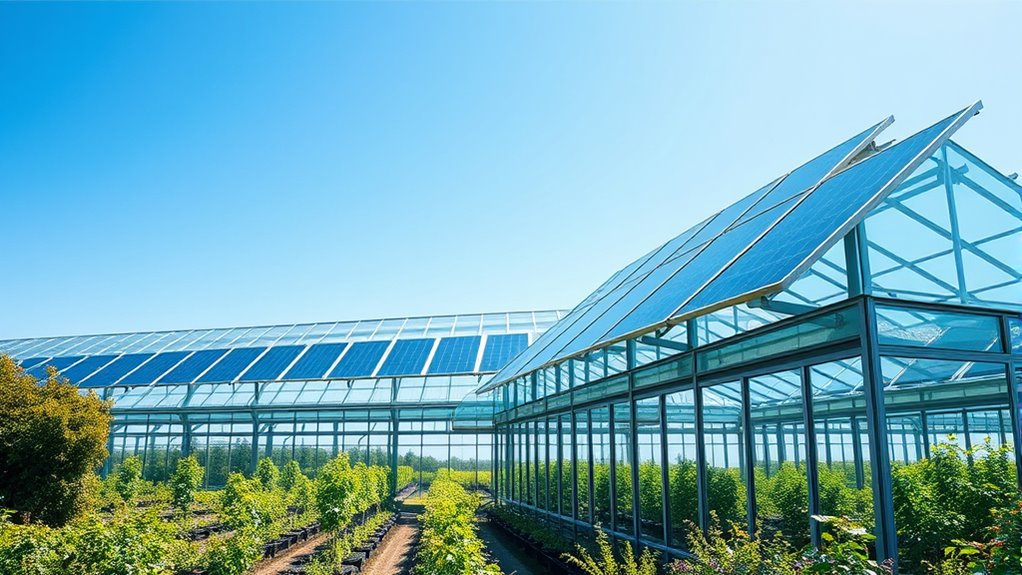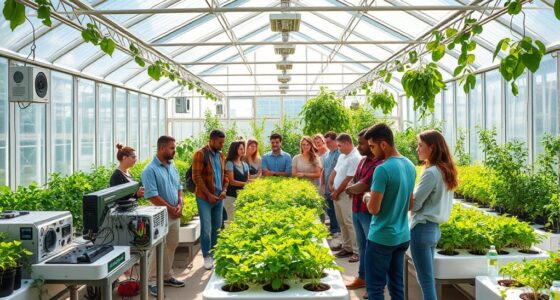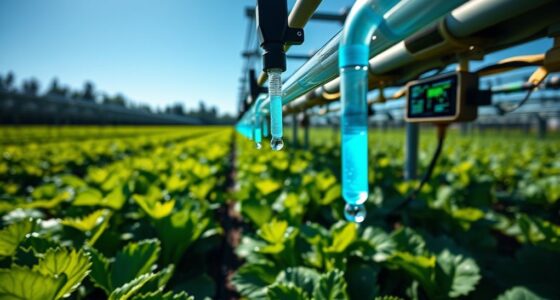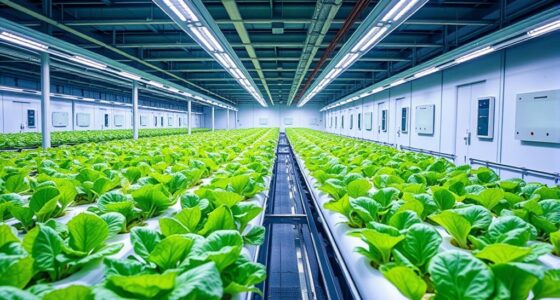Integrating solar power into your greenhouse boosts energy efficiency and cuts operational costs by harnessing high-efficiency solar panels that maximize sunlight capture in limited space. This renewable energy reduces reliance on fossil fuels, stabilizes power supply with storage options like batteries, and helps maintain ideal growing conditions through thermal management strategies. By combining solar technology with smart climate control, you create a sustainable, eco-friendly operation. Exploring further reveals how you can optimize these systems for long-term success.
Key Takeaways
- High-efficiency solar panels maximize energy capture, supporting climate control and irrigation systems in greenhouses.
- Solar power reduces reliance on fossil fuels, lowering operational costs and environmental impact.
- Integrating thermal management strategies optimizes temperature and humidity, ensuring optimal plant growth.
- Regular system monitoring and maintenance sustain peak solar panel performance and energy reliability.
- Combining solar energy with sustainable practices enhances productivity and promotes eco-friendly agriculture.

Have you ever wondered how we can seamlessly incorporate renewable energy sources into our existing power systems? One promising approach is integrating solar-powered greenhouses, which combine energy generation with sustainable agriculture. To make this work effectively, understanding solar panel efficiency plays a crucial role. High-efficiency solar panels capture more sunlight and convert it into electricity more effectively, which means your greenhouse can generate enough power to operate climate control systems, lighting, and even water pumps. As you select solar panels, prioritize those with better efficiency ratings, especially if space is limited. This ensures you maximize energy output without requiring extensive land, making your greenhouse more self-sufficient and environmentally friendly.
Enhance your greenhouse with high-efficiency solar panels for maximum energy and sustainability.
But generating power is only part of the solution. Managing the internal environment of your greenhouse is equally vital, and that’s where greenhouse thermal management comes into play. Proper thermal management maintains a stable climate inside your greenhouse, optimizing plant growth while conserving energy. When you integrate solar power, you can use excess energy to regulate temperature and humidity, reducing reliance on traditional heating or cooling systems that consume fossil fuels. Smart ventilation, shading, and insulation can work hand-in-hand with solar energy systems to keep your greenhouse at ideal conditions during varying weather patterns. Thermal management is essential for ensuring a balanced environment and maximizing crop yields. Additionally, integrating energy storage solutions like batteries allows you to store excess power for use during low-light conditions, further enhancing system reliability. Employing monitoring systems can help track performance and ensure your system operates at peak efficiency over time.
Incorporating solar-powered systems also means considering how to balance energy production with consumption. During peak sunlight hours, your solar panels produce the most energy, so you can store excess power in batteries or use it directly for heating or cooling. When sunlight diminishes, stored energy ensures your greenhouse remains stable, preventing temperature swings that could harm your plants. This synergy between solar panel efficiency and thermal management creates a resilient system that adapts to changing conditions, reducing your operational costs and environmental footprint. Efficiency ratings play a vital role in selecting the best solar panels for your setup.
Furthermore, integrating these systems requires careful planning and ongoing monitoring. You’ll want to track solar energy production to ensure your panels operate at optimal efficiency, cleaning them regularly to remove dirt and debris. Simultaneously, you can fine-tune your thermal management strategies—like adjusting shading or ventilation—to maximize energy savings and plant health. Over time, you’ll develop a smarter, more responsive greenhouse that leverages renewable energy seamlessly.
In essence, by focusing on solar panel efficiency and effective greenhouse thermal management, you can transform a conventional greenhouse into a sustainable, energy-efficient operation. This integration not only supports eco-friendly practices but also boosts productivity and reduces long-term costs, making renewable energy a practical choice for modern agriculture. Additionally, incorporating juice cleansing principles can help maintain the health and vitality of your team working in the greenhouse, ensuring they stay energized and focused on sustainable practices.
Frequently Asked Questions
What Are the Initial Costs of Solar-Powered Greenhouse Systems?
The initial investment for solar-powered greenhouse systems can vary widely, depending on size and technology. You might expect costs ranging from tens of thousands to hundreds of thousands of dollars. Luckily, you have financing options like loans or grants to help cover these expenses. While upfront costs are significant, the long-term savings on energy bills and sustainability benefits often outweigh the initial investment.
How Do Solar Panels Affect Greenhouse Interior Temperatures?
You might think solar panels cool greenhouses, but they actually influence interior temperatures through shading. Solar panel shading can reduce heat gain on sunny days, helping with temperature regulation, especially in hot climates. However, they may also block some sunlight, potentially lowering overall light levels. Proper placement and design optimize solar panel shading, balancing energy production with maintaining ideal greenhouse temperatures for healthy plant growth.
Are There Government Incentives for Installing Solar-Powered Greenhouses?
You should know that many governments offer incentives like grants and tax incentives to encourage installing solar-powered greenhouses. These programs aim to support renewable energy use and sustainable farming practices. By taking advantage of government grants, you can offset installation costs, making solar energy more affordable. Tax incentives further reduce your expenses, helping you invest in eco-friendly greenhouse solutions. Check local policies to see what’s available in your area.
How Reliable Is Solar Energy During Winter Months?
Imagine a winter morning, sunlight filtering through snow-covered panes, casting a gentle glow. During winter months, solar energy’s reliability dips due to shorter daylight hours and snow coverage that can block sunlight. However, with optimized panel placement, snow-resistant technology, and energy storage systems, your solar setup can still produce power. While less consistent than in summer, solar energy remains a viable, eco-friendly option for your greenhouse year-round.
What Maintenance Is Required for Solar-Powered Greenhouse Systems?
You need to perform regular maintenance on your solar-powered greenhouse systems to keep them running efficiently. This includes panel cleaning to remove dirt and debris that reduce energy absorption. Additionally, you should check your inverters periodically to guarantee they’re functioning properly and efficiently converting solar energy. Regular inspections and maintenance help maximize energy production and prolong the lifespan of your system, making your greenhouse more sustainable and productive.
Conclusion
Think of solar-powered greenhouses as the sunflower turning its face to the sun, embracing renewable energy to flourish. By integrating solar power, you’re not just growing plants—you’re cultivating a sustainable future. Each solar panel is a petal, capturing sunlight and converting it into life-giving energy. When you harness renewable energy in your greenhouse, you’re planting seeds of innovation that bloom into a greener, more resilient world. Embrace this change, and watch your garden thrive with vigor.










